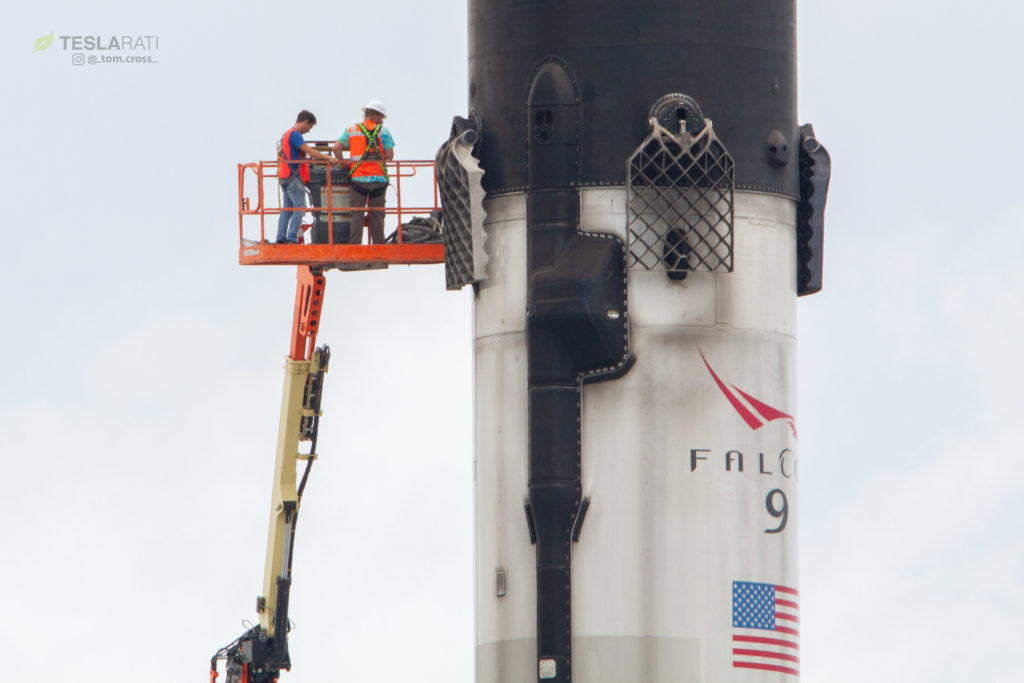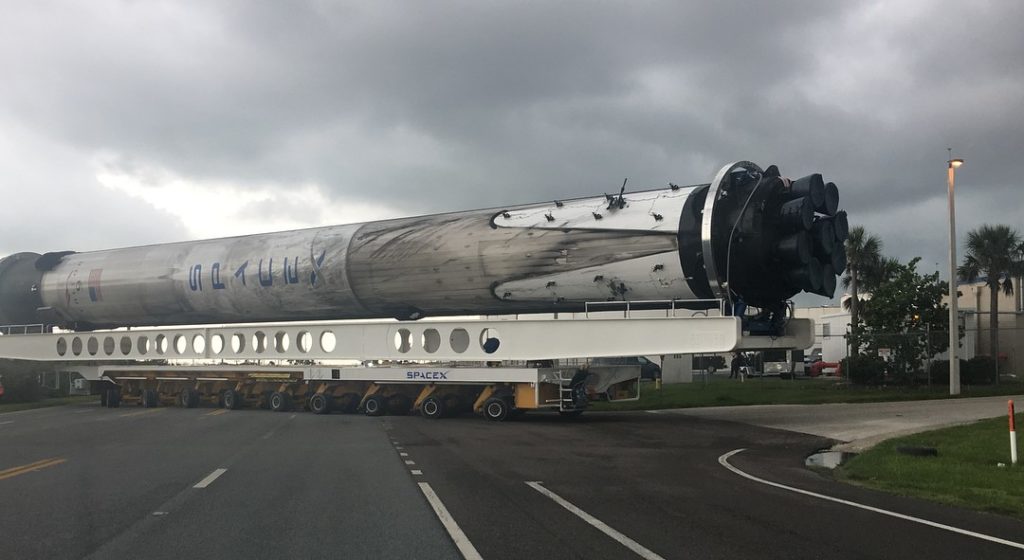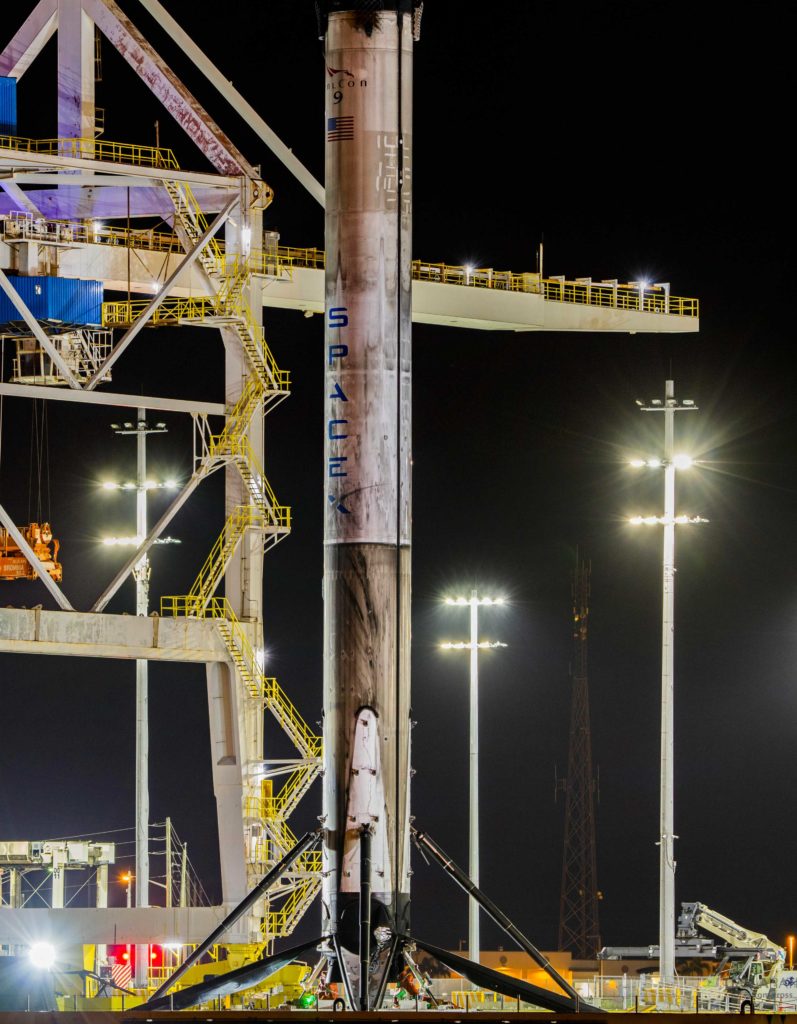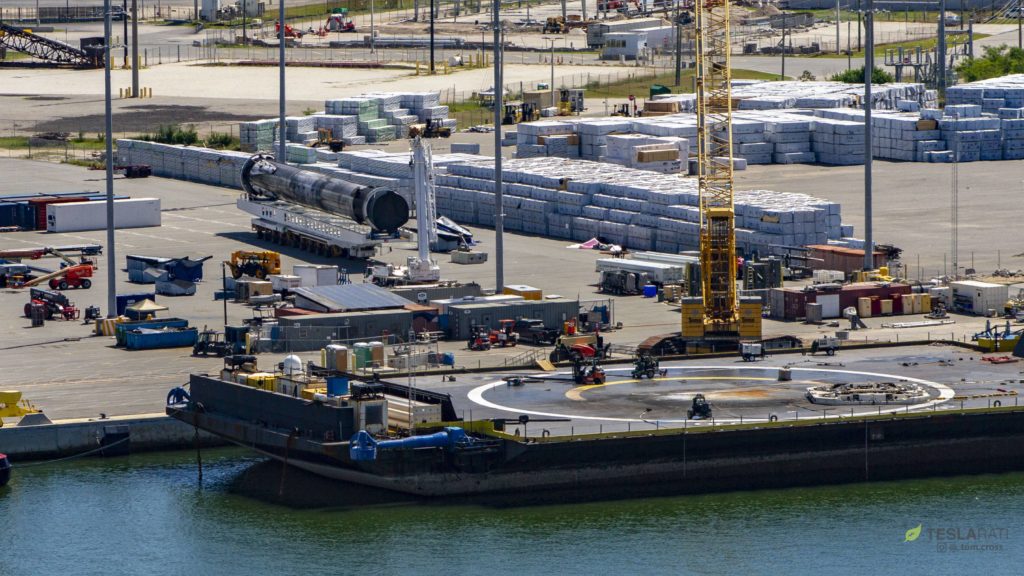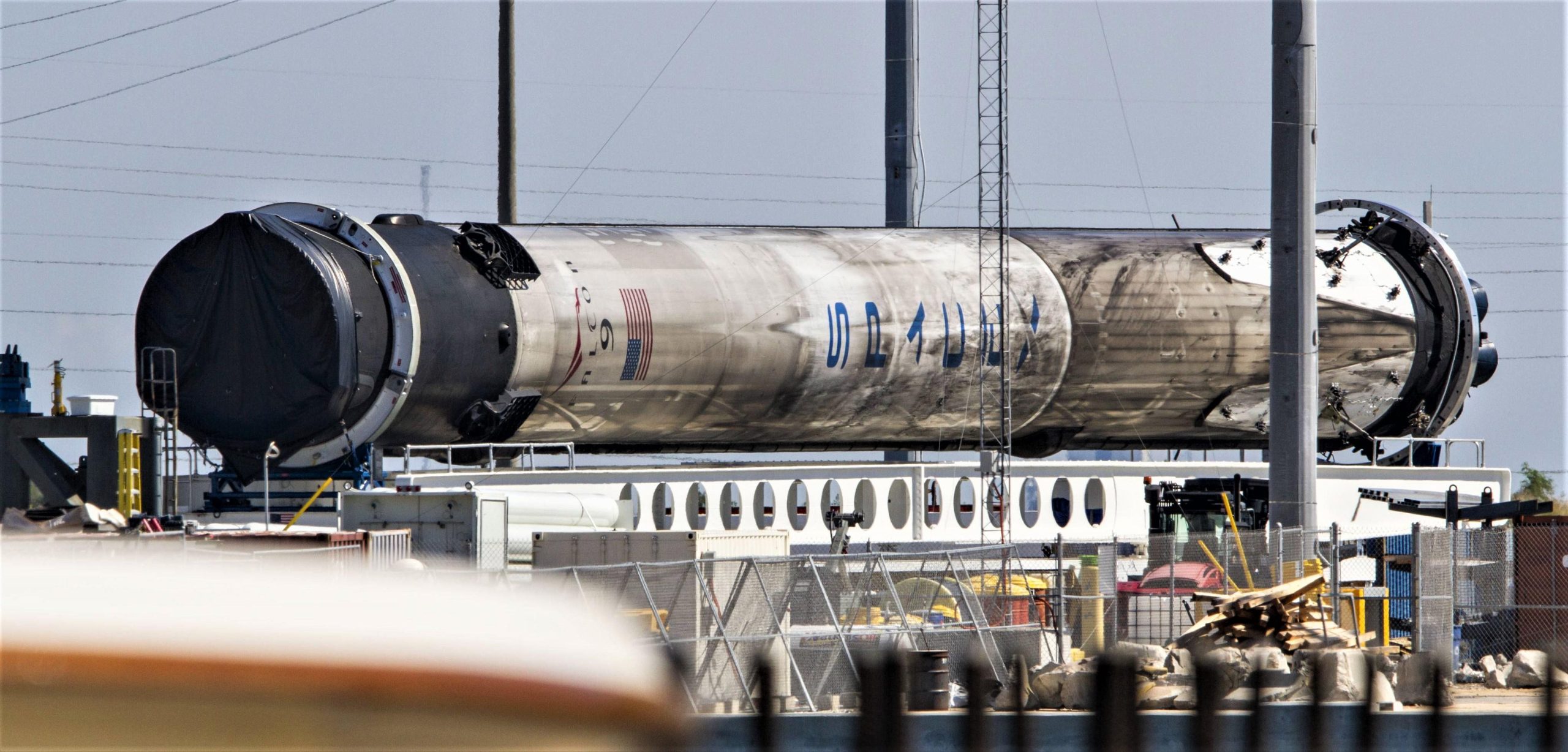
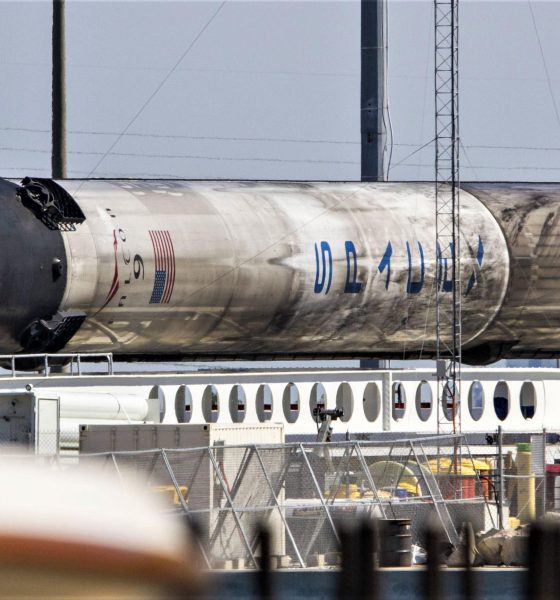
News
SpaceX’s Falcon 9 Block 5 rocket looks no worse for wear after dual launches
SpaceX’s first Falcon 9 Block 5 booster has returned to Port Canaveral, FL once again after the rocket’s second successful launch, likely the first of countless reuses to come over the next months and years. Of note, B1046.2 (Booster 1046, flight 2) was by all appearances in as good of condition as it was when it lifted off from Pad 40 just three days prior.
While it may be difficult to immediately distinguish between B1046’s second launch and recovery and those of previous, older Falcon 9 boosters, Block 5 is a quite simply an entirely different story. Moreover, the fact that SpaceX went from the major upgrade’s launch debut to first booster reflight in barely three months is an extraordinarily good indication that Block 5’s first flightworthy design (especially the parts not visible to the public) is very close to its engineers’ theoretical intentions.
Some additional shots of today's B1046.2 return to port. @SpaceX @SpaceXUpdates @elonmusk @SpaceXFleet #SpaceX pic.twitter.com/d4ivQ8PRuU
— The Aerospace Geek (@ThAerospaceGeek) August 10, 2018
Falcon 9 B1046’s second recovery also happened to be the quickest yet for SpaceX by a healthy margin, taking just 4.5 days to travel 400 miles back to port, be lifted off drone ship Of Course I Still Love You, have its legs removed, and be loaded horizontally onto SpaceX’s dedicated Cape Canaveral booster transporter. Whether or not the rocket itself is ready for another flight with absolutely zero refurbishing in between, this demonstration of just how quickly SpaceX’s infrastructure can operate indicates that much of the framework needed for truly rapid reuse is already largely in place.
Once SpaceX is confident that Block 5 can be reflown with little more than new fuel added and has lined up multiple payloads for launch in just a few days or weeks, it’s clear that the company will already have the ability to launch (and reuse rockets) so quickly that drone ship availability will become the primary bottleneck. For example, if B1046 could have shipped to one of SpaceX’s launch sites moments after it was loaded on its transporter and prepped for the second launch within 24-48 hours of going horizontal, it’s extremely unlikely that OCISLY could be readied for another booster recovery and towed several hundred miles off the coast in time to catch B1046 after its third launch.
- B1046 returned to Port Canaveral shortly after its May 4 debut, and is now being carefully analyzed as pathfinder hardware. (Tom Cross)
- Soon after, B1046 was spotted on its way to a refurbishment facility around a week after its May 11 launch debut. (Instagram /u/tersco)
- It’s currently unclear whether B1046 or B1048 will become the first SpaceX rocket to fly three times. (Tom Cross)
- 60 hours after docking, B1046 was loaded horizontally onto its transporter. (Tom Cross)
- SpaceX’s rocket-securing robot, known as Octagrabber, seen on OCISLY after another successful rocket recovery, August 12th. (Tom Cross)
As such, barring the extremely rapid completion of SpaceX’s third drone ship (named A Shortfall of Gravitas), it can be all but guaranteed that SpaceX will need to use its land-based Landing Zone 1 to accomplish CEO Elon Musk’s challenge of launching, landing, and relaunching the same Falcon 9 booster in less than 24 hours sometime before the end of 2019. Even then, it seems likely that SpaceX would either need to dramatically improve the turnaround capabilities of one of its launch sites or conduct those back-to-back launches using both of the company’s two Florida pads (LC-39A and LC-40).
Regardless, the first reuse of a Falcon 9 Block 5 booster unequivocally marks the beginning of a new era for SpaceX and for orbital rocketry worldwide. According to one of SpaceX’s webcast hosts during the second flight of B1046 (for the launch of Telkom 4/Merah Putih), the rocket’s third launch (a first for SpaceX) is already in planning for an unspecified mission later this year. As SpaceX rockets begin to rack up 3, 5, 10, or more launches apiece and the act of reusing Falcon 9s becomes so routine that it bores all but the most ardent followers, you’ll know that SpaceX has essentially succeeded in the first step of its master plan. Next stop: BFR and Mars.
For prompt updates, on-the-ground perspectives, and unique glimpses of SpaceX’s rocket recovery fleet (including fairing catcher Mr Steven) check out our brand new LaunchPad and LandingZone newsletters!

News
Tesla FSD fleet is nearing 7 billion total miles, including 2.5 billion city miles
As can be seen on Tesla’s official FSD webpage, vehicles equipped with the system have now navigated over 6.99 billion miles.

Tesla’s Full Self-Driving (Supervised) fleet is closing in on almost 7 billion total miles driven, as per data posted by the company on its official FSD webpage.
These figures hint at the massive scale of data fueling Tesla’s rapid FSD improvements, which have been quite notable as of late.
FSD mileage milestones
As can be seen on Tesla’s official FSD webpage, vehicles equipped with the system have now navigated over 6.99 billion miles. Tesla owner and avid FSD tester Whole Mars Catalog also shared a screenshot indicating that from the nearly 7 billion miles traveled by the FSD fleet, more than 2.5 billion miles were driven inside cities.
City miles are particularly valuable for complex urban scenarios like unprotected turns, pedestrian interactions, and traffic lights. This is also the difference-maker for FSD, as only complex solutions, such as Waymo’s self-driving taxis, operate similarly on inner-city streets. And even then, incidents such as the San Francisco blackouts have proven challenging for sensor-rich vehicles like Waymos.
Tesla’s data edge
Tesla has a number of advantages in the autonomous vehicle sector, one of which is the size of its fleet and the number of vehicles training FSD on real-world roads. Tesla’s nearly 7 billion FSD miles then allow the company to roll out updates that make its vehicles behave like they are being driven by experienced drivers, even if they are operating on their own.
So notable are Tesla’s improvements to FSD that NVIDIA Director of Robotics Jim Fan, after experiencing FSD v14, noted that the system is the first AI that passes what he described as a “Physical Turing Test.”
“Despite knowing exactly how robot learning works, I still find it magical watching the steering wheel turn by itself. First it feels surreal, next it becomes routine. Then, like the smartphone, taking it away actively hurts. This is how humanity gets rewired and glued to god-like technologies,” Fan wrote in a post on X.
News
Tesla starts showing how FSD will change lives in Europe
Local officials tested the system on narrow country roads and were impressed by FSD’s smooth, human-like driving, with some calling the service a game-changer for everyday life in areas that are far from urban centers.

Tesla has launched Europe’s first public shuttle service using Full Self-Driving (Supervised) in the rural Eifelkreis Bitburg-Prüm region of Germany, demonstrating how the technology can restore independence and mobility for people who struggle with limited transport options.
Local officials tested the system on narrow country roads and were impressed by FSD’s smooth, human-like driving, with some calling the service a game-changer for everyday life in areas that are far from urban centers.
Officials see real impact on rural residents
Arzfeld Mayor Johannes Kuhl and District Administrator Andreas Kruppert personally tested the Tesla shuttle service. This allowed them to see just how well FSD navigated winding lanes and rural roads confidently. Kruppert said, “Autonomous driving sounds like science fiction to many, but we simply see here that it works totally well in rural regions too.” Kuhl, for his part, also noted that FSD “feels like a very experienced driver.”
The pilot complements the area’s “Citizen Bus” program, which provides on-demand rides for elderly residents who can no longer drive themselves. Tesla Europe shared a video of a demonstration of the service, highlighting how FSD gives people their freedom back, even in places where public transport is not as prevalent.
What the Ministry for Economic Affairs and Transport says
Rhineland-Palatinate’s Minister Daniela Schmitt supported the project, praising the collaboration that made this “first of its kind in Europe” possible. As per the ministry, the rural rollout for the service shows FSD’s potential beyond major cities, and it delivers tangible benefits like grocery runs, doctor visits, and social connections for isolated residents.
“Reliable and flexible mobility is especially vital in rural areas. With the launch of a shuttle service using self-driving vehicles (FSD supervised) by Tesla in the Eifelkreis Bitburg-Prüm, an innovative pilot project is now getting underway that complements local community bus services. It is the first project of its kind in Europe.
“The result is a real gain for rural mobility: greater accessibility, more flexibility and tangible benefits for everyday life. A strong signal for innovation, cooperation and future-oriented mobility beyond urban centers,” the ministry wrote in a LinkedIn post.
News
Tesla China quietly posts Robotaxi-related job listing
Tesla China is currently seeking a Low Voltage Electrical Engineer to work on circuit board design for the company’s autonomous vehicles.

Tesla has posted a new job listing in Shanghai explicitly tied to its Robotaxi program, fueling speculation that the company is preparing to launch its dedicated autonomous ride-hailing service in China.
As noted in the listing, Tesla China is currently seeking a Low Voltage Electrical Engineer to work on circuit board design for the company’s autonomous vehicles.
Robotaxi-specific role
The listing, which was shared on social media platform X by industry watcher @tslaming, suggested that Tesla China is looking to fill the role urgently. The job listing itself specifically mentions that the person hired for the role will be working on the Low Voltage Hardware team, which would design the circuit boards that would serve as the nervous system of the Robotaxi.
Key tasks for the role, as indicated in the job listing, include collaboration with PCB layout, firmware, mechanical, program management, and validation teams, among other responsibilities. The role is based in Shanghai.
China Robotaxi launch
China represents a massive potential market for robotaxis, with its dense urban centers and supportive policies in select cities. Tesla has limited permission to roll out FSD in the country, though despite this, its vehicles have been hailed as among the best in the market when it comes to autonomous features. So far, at least, it appears that China supports Tesla’s FSD and Robotaxi rollout.
This was hinted at in November, when Tesla brought the Cybercab to the 8th China International Import Expo (CIIE) in Shanghai, marking the first time that the autonomous two-seater was brought to the Asia-Pacific region. The vehicle, despite not having a release date in China, received a significant amount of interest among the event’s attendees.
